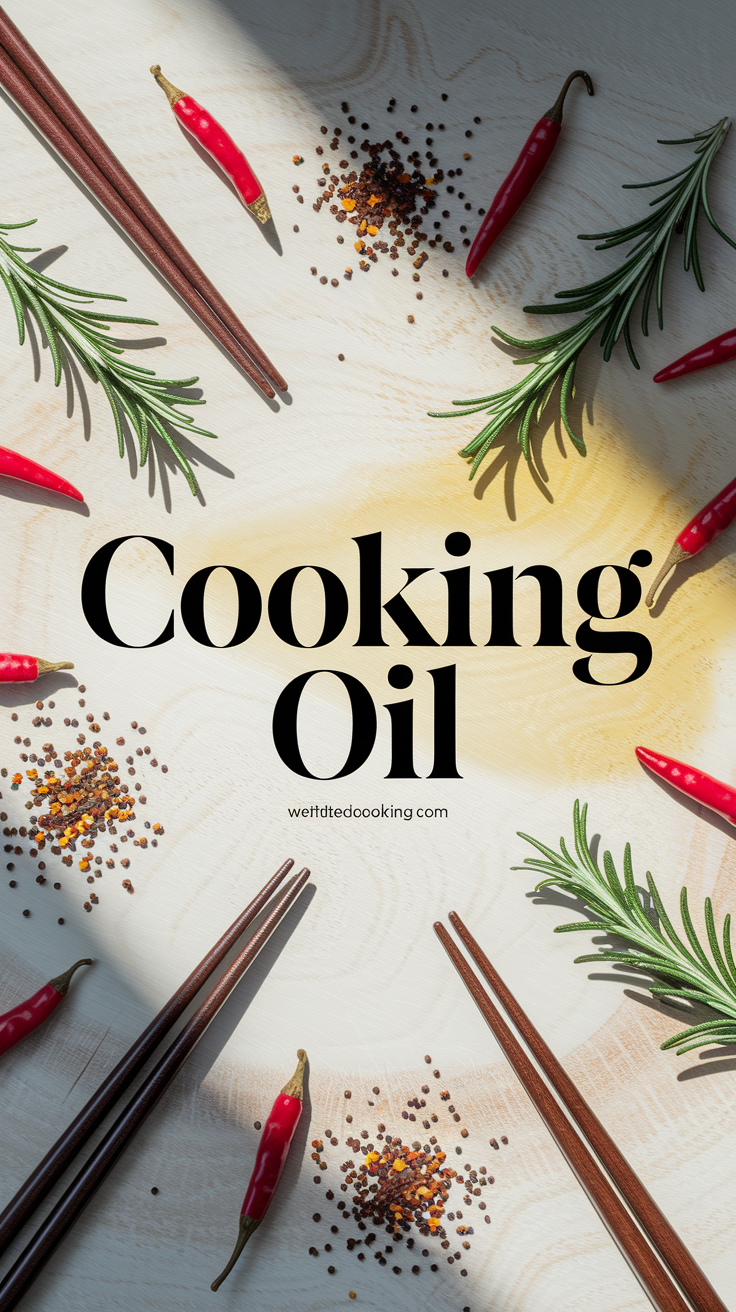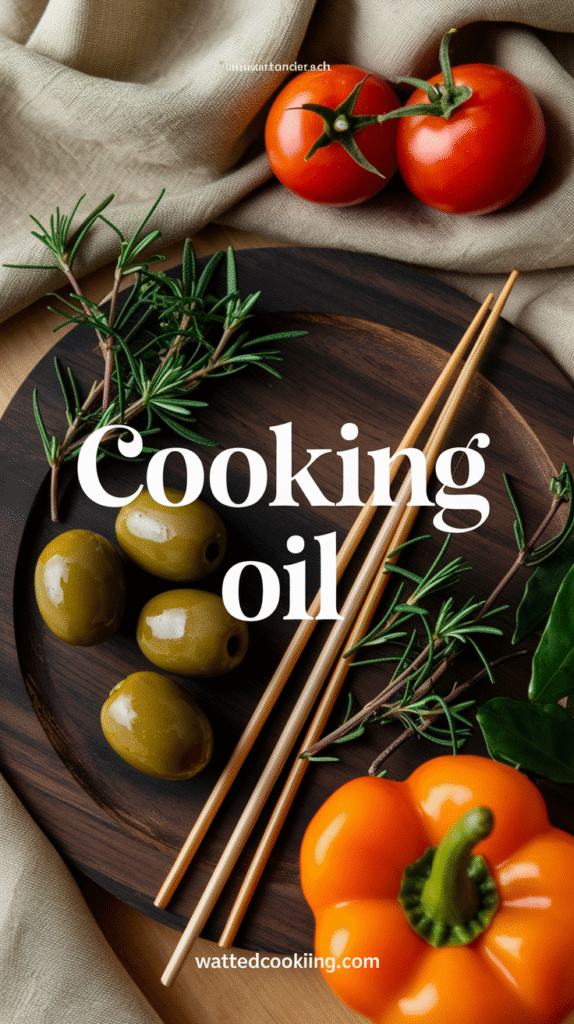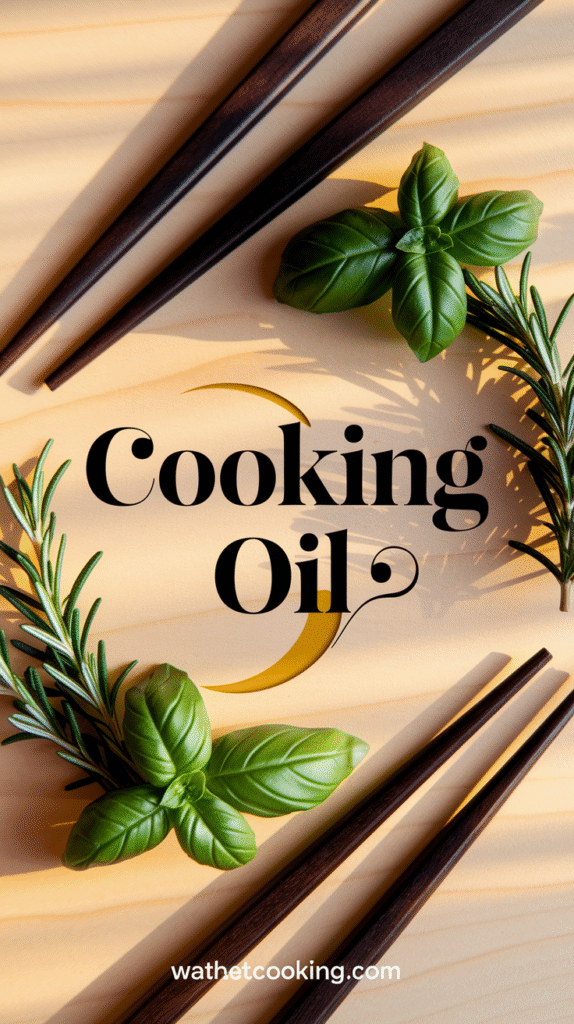Cooking oil is a staple in every kitchen, serving multiple purposes from frying and sautéing to baking and salad dressing. With so many types available, it can be confusing to choose the right one for your needs. Understanding the different types of cooking oils and their properties allows you to make informed decisions that enhance your cooking and health.
Types of Cooking Oil
Different cooking oils provide unique flavors, smoke points, and health benefits. Here’s a list of popular cooking oils you might consider:
- Olive Oil: This oil is a favorite for dressing salads and sautéing vegetables. Extra virgin olive oil, with its rich flavor profile, is perfect for drizzling over dishes.
- Canola Oil: Affordable and versatile, canola oil has a high smoke point. It’s excellent for frying and baking.
- Coconut Oil: Known for its unique taste and health properties, coconut oil can be used for high-heat cooking or in baking.
- Avocado Oil: With great health benefits and a high smoke point, avocado oil is perfect for grilling and frying.
- Grapeseed Oil: This light oil is ideal for dressings and low-heat cooking. Its neutral flavor allows other tastes to shine.
- Sesame Oil: Often used in Asian cuisine, sesame oil adds a distinct flavor to stir-fries and dressings. There are both light and dark varieties, each with unique flavors.
Choosing the Right Cooking Oil
Selecting the right cooking oil involves considering several factors, including culinary use, flavor, and health aspects.
Smoke Point and Culinary Uses
The smoke point is the temperature at which an oil begins to burn and smoke. When choosing your cooking oil, it’s important to opt for oils with the appropriate smoke point for your cooking method.
- High Smoke Point Oils (above 400°F): Canola, avocado, and peanut oils are ideal for frying and searing.
- Medium Smoke Point Oils (350°F – 400°F): Olive oil and sesame oil work well for sautéing and baking.
- Low Smoke Point Oils (below 350°F): Flaxseed and extra virgin olive oil are better for drizzling or dressings.
Health Considerations
When picking a cooking oil, consider its fatty acid profile. Some oils are high in saturated fats, while others contain healthier unsaturated fats. Here’s a quick overview:
- Olive Oil: Rich in monounsaturated fats, it’s known for heart health.
- Coconut Oil: Contains medium-chain triglycerides, which some studies suggest can boost metabolism.
- Canola Oil: Low in saturated fat and high in omega-3 fatty acids.
Flavor and Cooking Styles
The flavor of the oil can significantly impact your dish. For instance, olive oil lends a robust flavor to salads and roasted vegetables, while grapeseed oil offers a more neutral taste for cooking. Here’s how flavor profiles of oils can influence your cooking:
| Oil Type | Flavor Profile | Best Uses |
|---|---|---|
| Olive Oil | Fruity and peppery | Salads, roasting |
| Coconut Oil | Sweet and tropical | Baking, frying |
| Sesame Oil | Nuts and earthy | Asian dishes, marinades |
Storing Cooking Oils
Proper storage of cooking oil preserves its quality and extends its shelf life. Store oils in a cool, dark place. Avoid exposing them to light or heat to prevent rancidity. Also, always check if the oil has a stale smell before use.
The versatility of cooking oil makes it a vital ingredient in your kitchen. By understanding your options and their specific uses, you can elevate your cooking and ensure that every dish is delicious and healthy. For more information about cooking oils and their health benefits, visit Healthline or Verywell Fit.
Health Benefits and Risks Associated with Different Cooking Oils
Cooking oils play a crucial role in our daily meals, influencing both flavor and health. Different types of cooking oils offer a variety of health benefits as well as risks. Understanding these aspects can help you choose the best oil for your cooking needs.
When selecting a cooking oil, it’s essential to consider factors like smoke point, nutritional profile, and potential health effects. Here’s a closer look at some popular oils:
| Cooking Oil | Health Benefits | Risks | Best Uses |
|---|---|---|---|
| Olive Oil |
|
| Salads, sautéing, drizzling over dishes |
| Coconut Oil |
|
| Baking, frying, tropical dishes |
| Canola Oil |
|
| Frying, baking, roasting |
| Avocado Oil |
|
| High-heat frying, salads, drizzling |
| Soybean Oil |
|
|
It’s important to choose your oils wisely. Olive oil, for instance, is commonly regarded as one of the healthiest options due to its rich antioxidant content and heart-healthy fats. It’s best to use it for dressings or low to medium cooking temperatures. Conversely, while coconut oil is popular, particularly in the wellness community, its saturated fat content can be concerning if consumed excessively.
Meanwhile, oils like canola and soybean, while versatile and frequently used in processed foods, can be highly refined. Such processing may strip them of beneficial nutrients. Additionally, the omega-6 fatty acids in these oils can lead to an imbalance when excessively consumed without omega-3s.
Another aspect to consider is the oil’s smoke point, which is the temperature at which it starts to smoke and break down. Using an oil beyond its smoke point can produce harmful compounds and affect the flavor of your food. Here’s a quick reference table for smoke points of common cooking oils:
| Cooking Oil | Smoke Point (°F) |
|---|---|
| Olive Oil (Extra Virgin) | 320-410 |
| Canola Oil | 400-450 |
| Coconut Oil | 350 |
| Avocado Oil | 520 |
| Soybean Oil | 450 |
Ultimately, experimenting with different oils can help you discover flavors and benefits that suit your lifestyle. Whether you’re using oil for frying, dressing salads, or baking, the choice of cooking oil can significantly impact your health.
If you want to delve deeper into the impacts of cooking oils on your health, consider visiting Healthline for comprehensive information on various cooking oils and their benefits.
Being aware of the health benefits and risks associated with different cooking oils will assist you in making informed dietary choices. The right oil can enhance your dishes while also promoting better health.
How to Store Cooking Oil Properly for Maximum Freshness
Proper storage of cooking oil can make a significant difference in its flavor, quality, and safety for meals. Cooking oil comes in various types, including vegetable, olive, and coconut oil, and each type has its unique properties and storage needs. Understanding how to store these oils not only extends their shelf life but also preserves their nutritional value and taste.
Choosing the Right Container
The first step in storing your cooking oil is selecting an appropriate container. Ideally, you should use a dark glass bottle or a tubular container that limits light exposure. Light can break down oil, making it rancid. If you purchase oil in bulk or transfer it, ensure the container is airtight and made from food-safe materials.
Protecting from Light and Heat
Cooking oil should be stored in a cool, dark place. Here’s a simple guide to help you remember:
- Store oils away from direct sunlight.
- A pantry or kitchen cabinet is ideal, away from heat sources like the stove or oven.
- Some oils, especially delicate ones like extra virgin olive oil, may even benefit from refrigeration.
Understanding Shelf Life
Each type of cooking oil has a different shelf life. Below is a helpful table summarizing the typical storage durations for various cooking oils:
| Type of Oil | Shelf Life at Room Temperature | Shel Life in Refrigerator |
|---|---|---|
| Olive Oil | 1 to 2 years | Up to 3 years |
| Vegetable Oil | 6 months to 1 year | Up to 1 year |
| Coconut Oil | 2 to 3 years | Indefinite if solid |
| Sesame Oil | 6 months to 1 year | 1 year |
To best utilize your cooking oil, remember to check the expiration date on the bottle. Even when stored properly, oils can go rancid. Rancid oil will have a distinct off smell and taste.
Avoiding Contamination
When using cooking oil, it’s crucial to avoid contamination. Here are tips to help:
- Use a clean, dry spoon or measuring cup when scooping oil.
- Avoid letting water or other food particles enter the oil container.
- Close the cap tightly after each use to keep air and moisture out.
Reusing Cooking Oil
If you intend to reuse cooking oil, such as after frying, it’s important to strain it to remove food particles. Store the strained oil in a clean, dry container. Reused oil has a shorter shelf life, so make a note of when you last used it.
Reused cooking oil is generally safe for frying again for at least 2-3 uses, but be vigilant for signs of rancidity or unusual smells. Furthermore, oils with a high smoke point, like canola or peanut oil, are better for reuse compared to oils with a low smoke point.
Identifying Rancidity
Knowing how to identify rancid cooking oil is crucial for your health. Signs of rancidity include:
- A foul or off-putting smell, often described as musty or metallic.
- A change in color, from golden brown to darker shades.
- A bitter or sharp taste.
If you notice any of these signs, it’s best to discard the oil. For reference on storage and benefits, visit The Kitchn or Healthline.
By following these guidelines, you can ensure that your cooking oil stays fresh, extends its shelf life, and enhances your culinary creations. Proper storage not only saves you money but also helps maintain the full flavor and nutritional benefits of your chosen oils.
The Impact of Cooking Oil on Flavor and Texture in Dishes
Cooking oil plays a crucial role in preparing various dishes, significantly influencing both flavor and texture. Different types of cooking oils impart unique tastes and can alter the overall mouthfeel of a meal. Understanding how these oils contribute to cooking can elevate your culinary skills and enhance your enjoyment of food.
When you heat oil, it interacts with other ingredients, releasing certain flavors and aromas that can either complement or overpower the dish. Here are some popular cooking oils and how they impact flavor:
- Olive Oil: This oil is famous for its fruity and slightly peppery taste. It works best with Mediterranean dishes and salads. Extra virgin olive oil can enhance the flavor of light foods.
- Canola Oil: Known for its neutral flavor, canola oil is excellent for frying and baking. It allows the other ingredients’ flavors to shine, making it a versatile choice.
- Sesame Oil: With its rich, nutty flavor, sesame oil is widely used in Asian cuisine. It adds depth to stir-fries and marinades.
- Coconut Oil: This oil exudes a tropical flavor, perfect for baking or curries. It can also add a slight sweetness to dishes, making it a favorite for desserts.
- Avocado Oil: Rich in healthy fats, avocado oil has a mild, buttery flavor. It’s ideal for drizzling on salads or using in dips.
Besides flavor, cooking oil significantly affects the texture of your dishes. The type of oil used can determine whether a dish is crispy, smooth, or creamy. Here’s how various oils contribute to texture:
- Frying: Oils with high smoke points, like peanut oil or grapeseed oil, are preferred for frying. They create a crispy texture when used at high temperatures.
- Baking: In baking, oils like vegetable or canola oil make cakes moist and tender. They integrate easily into batters, providing an even texture.
- Marinades: Oils used in marinades help to tenderize meats, making them juicier. They also enhance the meat’s overall mouthfeel.
- Sautéing: Using oils like olive or avocado for sautéing vegetables not only adds flavor but also helps maintain their crunchiness.
When selecting a cooking oil, it’s essential to consider both its flavor profile and its smoke point. The smoke point is the temperature at which oil begins to burn and smoke, which can affect the taste and health benefits of the dish. Here’s a comparison of popular cooking oils and their smoke points:
| Cooking Oil | Smoke Point (°F) | Flavor Profile |
|---|---|---|
| Olive Oil | 375-420 | Fruity, Peppery |
| Canola Oil | 400 | Neutral |
| Sesame Oil | 350 | Nutty |
| Coconut Oil | 350 | Tropical, Slightly Sweet |
| Avocado Oil | 520 | Mild, Buttery |
The right cooking oil into your dishes can change everything from the taste to the texture. Experimenting with various oils allows you to discover new flavors and improve your favorite recipes. Whether you are frying, sautéing, or baking, understanding oil characteristics can enhance your culinary creations.
For more information on cooking oil and its impact on dishes, check out resources like Fats for Health and Cooking Light. These sites offer expert insights on cooking oils, recipes, and health tips that can help you make informed choices in the kitchen.
Next time you reach for oil, think about how its flavor and texture can transform your cooking experience. Choosing the right oil is not just about health; it’s about enhancing taste and creating memorable meals.
Sustainable Choices: Eco-Friendly Cooking Oils and Their Uses
In today’s world, many people are becoming more conscious of their food choices and the impact these choices have on the environment. Cooking oil plays a vital role not just in our diets but also in our ecological footprint. Selecting eco-friendly cooking oils can be an easy step toward making sustainable choices in the kitchen.
What Makes Cooking Oils Eco-Friendly?
Eco-friendly cooking oils are derived from sustainable agricultural practices, which prioritize the health of the environment and biodiversity. These oils are often produced through methods that reduce chemical usage, conserve water, and minimize energy consumption. Below are some common sources of sustainable cooking oils:
- Olive Oil: When sourced from organic farms, olive oil boasts an extra-virgin quality, making it rich in antioxidants and a sustainable choice for many dishes.
- Coconut Oil: Sourced mainly from small-scale farmers, organic coconut oil not only benefits local communities but also requires less energy to produce compared to other oils.
- Sunflower Oil: High in vitamins and produced with fewer pesticides, sunflower oil is an excellent choice for frying and sautéing.
- Avocado Oil: Known for its high smoke point and rich nutrients, avocado oil is produced sustainably in many regions.
Comparing Popular Cooking Oils
When considering sustainable options, it’s helpful to compare the various oils based on their environmental impact, health benefits, and culinary uses. The following table outlines these aspects:
| Cooking Oil | Environmental Impact | Health Benefits | Culinary Uses |
|---|---|---|---|
| Olive Oil | Low pesticide usage | Rich in antioxidants | Salads, dressings |
| Coconut Oil | Supports local farmers | Medium-chain fatty acids | Baking, frying |
| Sunflower Oil | Less energy-intensive production | High in Vitamin E | Sautéing, frying |
| Avocado Oil | Low water footprint | Healthy fats, vitamins | Grilling, roasting |
Health Benefits of Eco-Friendly Cooking Oils
Choosing sustainable cooking oils also presents a host of health advantages. Many of these oils are high in beneficial nutrients, antioxidants, and healthy fats. For instance:
- Olive Oil: Known for its heart-health benefits, it’s packed with monounsaturated fats.
- Coconut Oil: Contains medium-chain triglycerides (MCTs) which may help improve metabolic rates.
- Sunflower Oil: Rich in linoleic acid, it contributes to healthy skin and heart health.
- Avocado Oil: High in oleic acid, it may help reduce inflammation and improve cholesterol levels.
How to Choose Sustainable Cooking Oils
When selecting cooking oils, consider these tips to make an eco-friendly choice:
- Look for certifications such as USDA Organic or Non-GMO Project Verified.
- Opt for oils bottled in recyclable or eco-friendly packaging.
- Purchase oils from reputable brands committed to sustainability.
Making the switch to eco-friendly cooking oils is not just a trend; it’s a commitment to a healthier planet and a healthier you. You can support your local community and reduce your carbon footprint with every meal you prepare. For more detailed information on sustainable oils and their benefits, visit reputable sources like FoodSafety.gov and Environmental Working Group.
Sustainable cooking oils into your daily cooking habits is a small but impactful way to contribute to a healthier environment and promote sustainable practices. So next time you reach for cooking oil, consider which type aligns with your eco-conscious values.
Conclusion
Cooking oil plays a vital role in both the culinary and nutritional domains of our lives. Understanding the versatility of different types of cooking oil allows you to enhance your kitchen creations with the right flavor and texture. Remember, the oil you choose can significantly influence not only how your dish tastes but also its health profile.
While some oils provide essential fatty acids and antioxidants that contribute to overall well-being, others may pose potential health risks if used excessively. It’s crucial to know the strengths and weaknesses of each type so you can make informed choices for yourself and your family.
Proper storage of cooking oil is often overlooked but is essential for maintaining its freshness and quality. Keep your oils in cool, dark places and sealed tightly to prevent oxidation. Fresh oil leads to better-tasting meals and maximizes the health benefits you can derive from it.
Moreover, embracing sustainable and eco-friendly cooking oils is a responsible choice that benefits not just your health but the planet as well. Seeking out oils derived from sustainable sources helps reduce environmental impact and promotes better agricultural practices.
By considering these factors—versatility, health impacts, proper storage, flavor contributions, and sustainability—you empower yourself to make conscious choices in the kitchen. The right cooking oil can elevate your culinary endeavors, support your health, and align with your values. Let these insights guide your journey toward better cooking and eating habits.







Leave a Reply